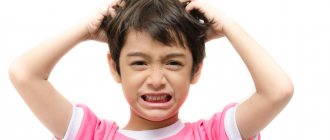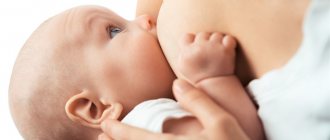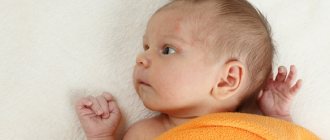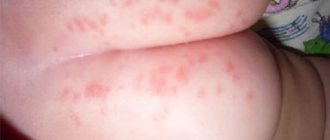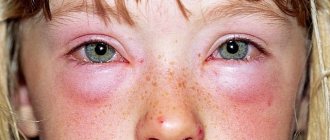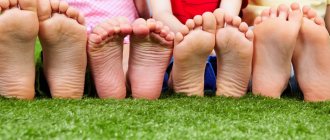Skin reactions upon direct contact with an allergen are the most common signs of the development of increased sensitivity of the body.
Allergic skin rashes can have such different shapes and sizes that it is impossible to immediately understand why the inflammation of the skin began. If you ignore it, in the future, when you encounter an allergen, you can get more serious reactions - indigestion, chronic conjunctivitis and rhinitis, respiratory manifestations - including the most severe one - Quincke's edema. During it, the laryngeal mucosa swells and blocks the windpipe - respiratory failure appears.
If medical attention is not provided immediately, the person dies.
What is an allergy
An allergic reaction is a reaction to the entry of a foreign antigen into the human body. It manifests itself with different symptoms. Some of them can be fatal. The main thing is to detect them in a timely manner and begin treatment.
Breasts have an imperfect immune system, so rashes are common in them. The older the baby gets, the fewer allergic manifestations he has.
It is impossible to completely cure allergies.
Allergic rashes on the face most often occur from food, dust, flowers, animal fur and chemicals. Treatment in childhood is carried out with antihistamine drops or gels.
Causes
All allergic reactions occur as a violation of the body's immune response to certain substances.
They are recognized by the immune system as hostile, which is why functions are launched to rid the body of them.
If once the body reacts with increased sensitivity to any substance from the environment, then subsequently its reaction will only intensify.
That is why it is so important to discover the source of the body’s hypersensitivity and, if possible, eliminate it from a person’s life.
Increased sensitivity can be caused by:
- components of cosmetics;
- household chemicals;
- plant pollen;
- animal hair;
- dust (book or house dust);
- medications;
- mold;
- insect bites;
- synthetic fabrics;
- Food.
This is not a complete list of possible allergens.
There are known cases of allergic reactions to the sun, to tobacco smoke, and even to money (the ink used to print banknotes and alloys for making coins).
The human body is such a complex system that it is impossible to completely predict how it will perceive a particular substance.
Causes of rashes on a baby's face
A rash on the face occurs in babies under one year of age. This is how the body reacts to new foods. Rashes often appear during the introduction of complementary foods, when the baby begins to get acquainted with adult food.
Introduction of complementary foods and allergies
Allergies in infants on the face
From 6 months, babies begin to try pureed vegetables, fruits and juices. You cannot introduce several foods into your diet at the same time. If a rash appears on your cheek, it will be difficult to understand which vegetable or fruit caused it.
Pediatricians recommend adhering to a specific complementary feeding regimen. They start with vegetables, and fruits are introduced a little later. The older the baby, the more varied his diet becomes.
Important! If a rash appears from any product, its administration is postponed for 1 month.
Allergies to medications and insect bites
Reactions to medications occur no less often than to food. For babies up to one year old, they try to prescribe medications only in an emergency. The therapy takes place under the strict supervision of a doctor.
Insect bites cause local allergies on the body, including the face. The reaction manifests itself in the form of swelling, itching, and redness. The swelling subsides within 3-5 days. In the summer, you need to try to protect the baby from insect bites; for this, use a mosquito net, light body covers, and baby sprays.
Red dots on the face
Ringworm
This is a disease of the upper layers of the skin. It is transmitted from infected pets and sick people. Ringworm spreads to the face, neck, behind the ears and scalp. A bright red, scaly rash appears that merges into one large scab. Treatment is prescribed by a dermatologist; it is necessary to undergo a series of tests to make a diagnosis.
Papular urticaria
This is a serious reaction of the body to an allergen, most often occurring in food. The child begins to break out in large blistering spots. They resemble herpes, filled with liquid inside. With prolonged exposure to the irritant, the papules merge into one large one, causing itching. Gradually the bubbles burst and dry out.
Important! You should not self-medicate; allergies are similar to many diseases that are easy to confuse.
Artificial feeding and allergies
Not all mothers are able to breastfeed their newborn. In such cases, children are prescribed artificial milk formula. Sometimes they are not suitable for children, then they begin to appear all over the body: on the palms, legs, tummy, back, face. If a rash appears, change the composition of the mixture to another.
Allergy to physical impact
The rarest allergic reactions are from exposure to the sun and cold. They appear in the form of small pinpoint rashes all over the body. During the unfavorable season, the child's skin is covered with clothing from exposure to sunlight or frost. In summer, they try to go for a walk in the afternoon.
Baby with red cheeks
Prickly heat
If you dress your newborn too warmly, he will begin to sweat a lot. Because of this, a small rash appears on the body, it is often localized in the armpits, buttocks, folds of the legs and arms. It is often confused with allergies; prickly heat goes away after water treatments and air baths.
Bloom
After 2-3 weeks, newborns may develop a small rash in the form of pimples on their face. Inside they are filled with white or light yellow liquid. By the age of three months, flowering, or neonatal acne, goes away on its own. It occurs due to hormonal changes in the child.
Eczema
This is a disease of the upper and inner layers of the skin. Eczema can be weepy or dry. Redness and itching appear on the body in the dry form. With wet eczema, the rash is accompanied by blisters with liquid, which burst and fill with pus. They need to be anointed with special medicinal ointments to avoid complications.
Important! If there are changes in the child’s skin, it is necessary to consult a dermatologist for a diagnosis.
Pimples on the palms of adults: causes!
Photo 17 - Pimples on the palms
The appearance of acne on the back of the hand brings discomfort to the usual lifestyle, since acne constantly itches and disrupts the aesthetic appearance of the hands.
Photo 18 - The problem of acne on the palms Photo 19 - Allergy in the form of acne on the palms
Causes of acne under the skin in adults:
How to cure acne on the palms?
Self-medication in this case is futile, since only a specialist will be able to identify the cause of the rash and prescribe a treatment program.
Photo 23 - A doctor will best help
Additionally, you can use folk recipes. For example, you can use the following recipe: you need to make juice from grated potatoes and moisten the sore areas of the skin with it.
Photo 24 - Potato juice will help with acne
Symptoms and localization of allergies
Red spots on the face of a newborn baby
Manifestations can occur on any part of the body. Food, drug, and dust allergies usually appear on the cheeks. The child develops small red blisters. Sometimes they look like a bright blush. The rash is a little itchy. When a new dose of allergen is added, the rash increases.
The baby is smeared with cream
How not to confuse allergies and neonatal rash
Neonatal rash and allergic manifestations are similar. Acne inside has a small white filling, does not cause itching, the size of the dots is only 1-2 mm. They are randomly located all over the face. With allergies, urticaria is localized in one place, accompanied by redness and itching.
How to understand what your baby is allergic to
To determine the type of allergen, you need to carefully monitor your baby's food. Introduce only one type of vegetable or fruit into the diet. New food is started with 1 tsp. in a day. If there are no manifestations, then the portion is increased; if there is, then stop.
When it is not possible to establish the cause of such a reaction in the body, you can do an allergy test. The doctor prescribes it and first discusses possible allergens with the parents.
After 1.5 years, children are allowed to undergo specific tests to determine the type of allergens. After examination and medical history, the doctor selects 4-5 allergenic dominant substances with a high probability of manifestation. Select 5 ampoules with a previously known composition.
Use a cotton pad to lubricate a small area of skin with the contents of each ampoule. Label the areas with a marker. Observe the reaction throughout the day. If there is swelling and redness, the result is positive.
Important! This analysis is prescribed for frequent occurrences of allergies.
The doctor decides how to treat a child’s facial allergies. He usually prescribes antihistamine drops for children. Kids drink them with pleasure, as they taste pleasant and sweet. The effect of the medicine occurs after a couple of days.
Important! Antiallergy medications cause drowsiness, this is normal.
Consumer Reviews
falkor27 (otzovik.com)
“The whole family has been using La Cree products for several years now. They have a wide range of products for problem skin and hair care. Tonics, shampoos, balms, lip balms, gels, foams, emulsions and oils.
Today I’ll tell you about La Cree cream for sensitive skin.
I am a mother of two daughters. I can say that this cream simply cannot be replaced, especially for children under one year old. It helps perfectly in relieving symptoms such as itching, irritation, redness, inflammation, peeling and so on.
Thanks to its natural composition, the cream can be used for a long time in children from birth. It copes well with dermatitis and diaper rash.
The cream contains:
- avocado oil;
- panthenol;
- licorice extract;
- walnut extract;
- bisabolol (a substance found in chamomile);
- violet extract;
- rosewood oil;
- string extract.
These components provide anti-inflammatory, antipruritic, soothing, regenerating, softening, nourishing, moisturizing, antimicrobial and healing effects.
Gray-beige cream with a pleasant herbal scent. Light non-greasy texture ensures easy absorption into the skin. When applied to dry, clean skin 1-2 times a day, the effect will not take long to appear. As a rule, relief occurs on the first day. A very good remedy for skin allergies and dermatitis. I recommend".
User (market.yandex.ru)
“A good cream for children, reduces redness, relieves itching after mosquito bites, gently cares for and restores the skin, natural composition.”
Sources:
- Kamasheva G.R., Khakimova R.F. Valiullina S.A., Methods for assessing the severity of atopic dermatitis in young children, Dermatology journal, 2010 https://cyberleninka.ru/article/v/metody-otsenki-stepeni-tyazhesti-atopicheskogo-dermatita-u-detey-rannego -vozrasta
- Kovyazina N.A., Fedosimova N.A., Illek Ya. Yu. Diagnosis of atopic dermatitis in young children, Vyatka Medical Bulletin, 2007 https://cyberleninka.ru/article/v/diagnostika-atopicheskogo-dermatita-u- children-early-vozrasta
- Smirnova G.I. Managing the course of the disease: atopic dermatitis in children, Russian pediatric journal, 2014 https://cyberleninka.ru/article/v/upravlenie-techeniem-bolezni-atopicheskiy-dermatit-u-detey
Photos of allergies in children
How are allergies dangerous for infants?
Rash on the face of a child - what is it, types of rashes
In infants, an allergic reaction can cause two serious conditions:
- Quincke's edema. The airways and limbs begin to swell, oxygen is cut off, and the child suffocates.
- Anaphylactic shock. This is a sharp inadequate reaction, the baby faints, cold sweat is released, convulsions, decreased pulse, vomiting, and death are possible.
Urgently call an ambulance if the first symptoms of such conditions are present.
How to recognize allergic acne
An allergic reaction of the body in the form of acne may not appear immediately after interaction with the allergen.
It may take from 10 minutes to two days before the first signs (redness of the skin or small pimples) appear.
Sometimes it is already difficult for a person to establish the relationship between what substance he came into contact with and the rash that appears. And the skin reaction will not always be local.
For example, a woman used Patentex Oval suppositories for contraception, and after a couple of days she discovered red pimples on her face. She was able to establish the relationship only after repeated use of this drug.
An allergic rash is usually distinguished from other acne by its appearance, location and accompanying symptoms.
If it is difficult to recognize on your own what type of rash has appeared, then the doctor usually diagnoses allergic acne without much difficulty.
Recommendations for caring for an allergic baby
What should I do about a child’s facial allergy that doesn’t go away and new ones constantly appear? Such children are assigned the status of allergy sufferers. They are prescribed special care:
- Ventilate the children's room regularly.
- Limit contact between baby and pets.
- Wet cleaning is carried out daily.
- Install an air humidifier in the room.
- Remove indoor flowering plants from the nursery.
- In the spring, take drops or tablets against allergies as a preventative measure during flowering.
Allergic children outgrow this condition with age. The older the baby gets, the fewer allergies he has.
If a child scratches an allergy on his face
Babies under one year old do not understand that they should not scratch rashes. Children scratch the rash until it bleeds. To relieve itching, use antihistamine ointments or folk remedies.
Grandma's best recipe is to lubricate the rash with a decoction consisting of chamomile and string. These herbs are hypoallergenic, help relieve itching, and promote healing.
The boy has one red cheek
Locations
Allergy pimples typically appear on areas of more sensitive skin.
- On the face these are the cheeks.
- In a baby, rashes in this area can indicate errors in nutrition (their own or the mother’s, if he is breastfed).
- Also, a child often develops pimples on the bottom or in the perineal area as a reaction to the diaper.
- Allergic rashes can be localized in skin folds: on the neck, under the arms, in the elbows and knees, on the inside of the wrist. Less commonly, they appear on the inside of the limbs and on the abdomen.
Prevention of allergies in children according to Komarovsky
Dr. Komarovsky advises children with allergies to carefully select food products. New fruits and vegetables are given to babies with caution. Only children's hypoallergenic powders are used for washing. When visiting a doctor, you should always warn him about this peculiarity of the baby so that individual treatment can be selected for him.
An allergic rash on the face of a child occurs most often due to food. Many infants face this problem in the first year of life. This occurs due to an imperfect immune system. As children age, they adapt to new foods and environments.
How to apply to an allergic rash in a child?
Treatment of rashes on the skin of an infant begins with a visit to a pediatrician, pediatric dermatologist and allergist.
Main stages of therapy:
- Eliminating contact with the allergen.
- Nutrition control.
- Selection of medicines.
- Using traditional methods.
Drug treatment
What medicine can be used? To eliminate an allergic rash in a baby, a specialist may prescribe:
- Antihistamines - Suprastin, Fenistil, Citrine, Erius and others. The medicine is selected depending on the irritant and the age of the child.
- Ointments and creams for topical application. Most often, the rash is smeared with Bepanten, Vundehil and Fenistil.
- Sorbents for removing toxins and allergic components from the body. Polysorb, Enterosgel and Laktofiltrum have proven their effectiveness.
- Sedatives.
- Corticosteroids are hormonal drugs that are required in severe cases of the disease.
- Diuretic medicine – needed for severe swelling.
ethnoscience
Used as an addition to the main treatment:
- Baths with medicinal herbs: chamomile, calendula, string or sage.
- Calendula decoction is given before meals, 1 tablespoon.
- Nettle infusion.
The products can only be used with the permission of a doctor.
Features of treatment
Treating allergic acne is not very easy.
After all, if the further influence of the allergen is not excluded, then they will take increasingly severe forms.
Treatment should only be prescribed by a doctor - an allergist or dermatologist.
How to treat allergic acne?
Photo: products for external use
Not only external agents are used, but also systemic drugs.
- Antiallergic ointments will help reduce swelling, inflammation and relieve severe itching. These are Fenistil, Psilobalm, Gistan, etc. Skin-cap helps relieve the symptoms of skin rashes, but it can only be used if ulcers and abrasions have not yet formed at the site of acne. In more severe cases, hormonal ointments are prescribed.
- Antihistamines must be prescribed internally: Diazolin, Suprastin, Zodak, Cetrin, Dezal, etc. They neutralize the effect of the irritating substance on the body and stop new rashes.
Photo: antihistamines for oral administration
- During allergic reactions, toxins are formed in the body, which can be removed by activated carbon, Enterosgel, Polyphepan or other absorbents.
- Calcium supplements are usually prescribed in combination with other medications.
Any medicine must be prescribed by a doctor.
Taking medications incorrectly can have serious consequences.
Questions and answers
How to distinguish hormonal hormones in newborns
Many young parents notice that acne appears on their infant in the first days of his life. Usually these are red spots with a raised center, at the top of which there is a small white grain (like millet).
Photo: hormonal rashes in a newborn
These are so-called milia, or hormonal acne.
Their appearance in a newborn is caused by the fact that in the first weeks the mother’s hormones are still present in his body. They cause increased activity of the sebaceous glands and lead to clogged pores.
Unlike acne in adults, milia do not bother the baby in any way.
You definitely need to see a doctor.
But if the hormonal origin of these rashes is confirmed, then there is no need to treat such pimples, they will go away on their own.
The main thing is to maintain the necessary hygiene.
Is it possible to smear with brilliant green
Usually, before visiting a specialist, it is not recommended to lubricate any rashes with brilliant green.
It takes a long time to wash off, so at the doctor’s appointment it will be difficult to see the color and structure of the skin and the formations that have appeared.
Allergic acne is not a trivial skin problem.
Symptomatic treatment may not give any result or the effect will be temporary.
This requires a serious approach and proper treatment prescribed by a specialist.


